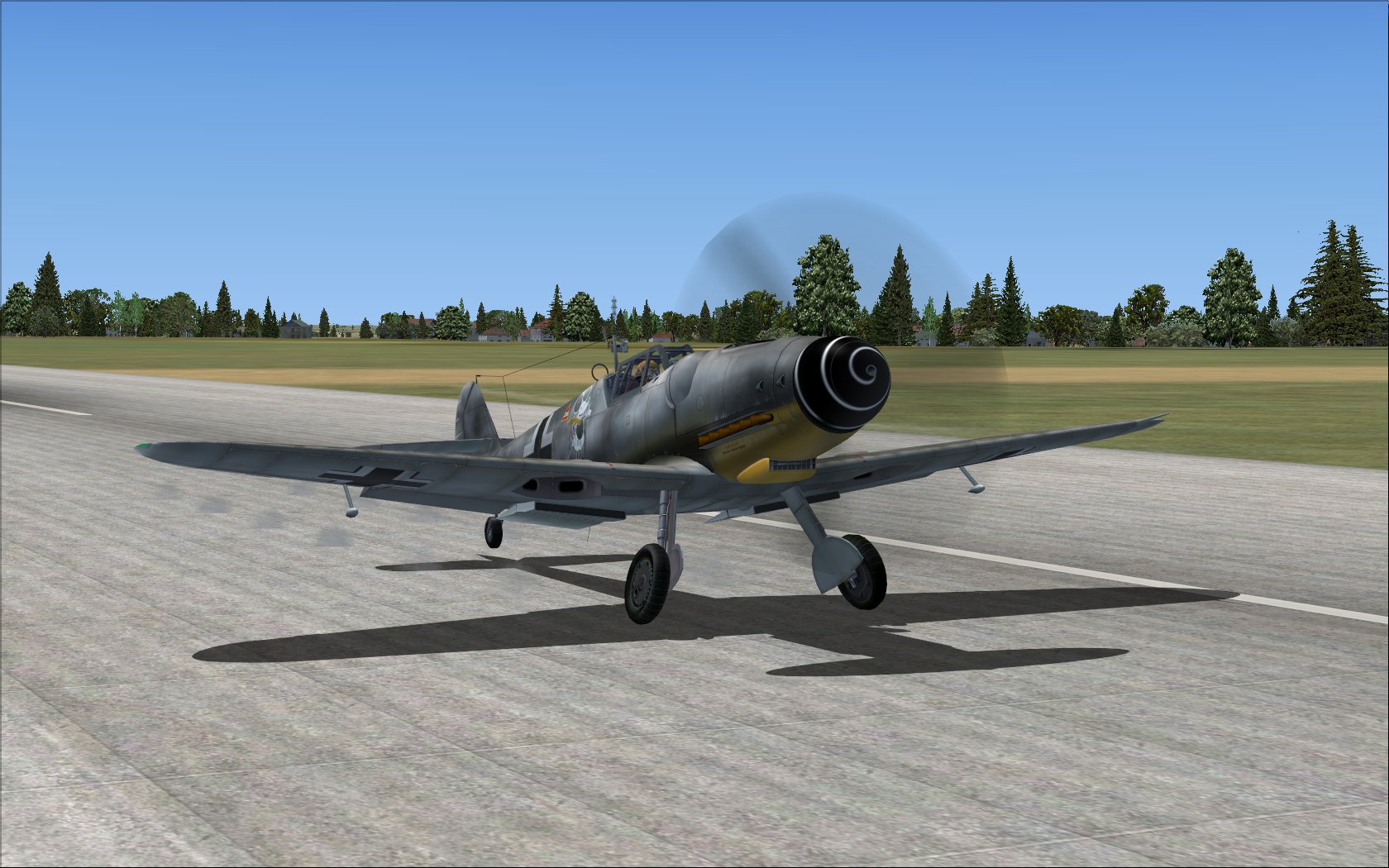
CWDT Bf-109G
The CWDT design team has specialized in
warbirds. They are among the few design teams left who specialize in the
roots of the combat flight simulator genre. So, it's always a welcome
addition when they offer a new thoroughbred to the livery. Their latest
release is the immortal Messerschmitt Bf-109G. The release comes with
several different textures and weapons loads, including some of the more unusual
Luftwaffe armaments, such as the 210mm mortar tubes. What you also find is
that with each of these weapons added, the performance of the aircraft is
noticeably affected in realistic ways. If you try to takeoff with a 250kg
bomb, full internal fuel, and wing mounted cannons, the aircraft will be
significantly tail heavy and you'll have to force the tail off the ground during
takeoff roll. Also, you'll need a lot more runway. This is a basic
weight and balance issue that real pilots flying actual aircraft face all the
time. It is nice frankly to have virtual aircraft designers model these
affects the way they should be.
It is clear the team researched their subject to a great degree. The details of the framing within the virtual cockpit proves this. The compound curves of the front windscreen are faithfully replicated, along with the sandwiching of the bullet-proof flat panel glass up front. Pilots of actual Bf-109's reported dissatisfaction with the abundance of framing on their aircraft. Even using Track IR 4 after flying this virtual copy, I can sympathize with their concerns. There are numerous blind spots and trying to dogfight inside this cockpit was a huge challenge.
The VC has other nice touches, including a slight clouding of the gauge glass covers. This is indicative of an aircraft kept outside in the sun too often. The gauges all work smoothly and accurately. My only lament with the VC is a relative absence of clickable switches. There's also a bug with the starter switch. When you try to press for an initial start, the engine coughs but doesn't crank. However, on subsequent starts it works well. The CWDT designers say they are working on that for a future update as well as modeling a master battery switch which is currently lacking.
When you look aft in the VC, you also notice
shinny screws holding the rear steel armor plate brackets with the aft
bullet-proof glass panel. You feel like you could reach out and touch
them! Such small details add to the immersion feeling. This is
reinforced by the cramped conditions, another lament that actual Bf-109 pilots
frequently made. They reported the cockpit was so narrow and confining,
that they couldn't even leverage their shoulders into moving the joystick for a
hard turn. Sitting in the VC all of these realities are very nicely
replicated. You feel like you are sitting inside a real Bf-109 cockpit and
the feeling seems far more realistic than I've personally felt with any
previously released Bf-109, freeware or payware. You spend a lot of time
flying this aircraft peering around frames and other obstructions. If you
don't have Track IR, then you really should consider buying it so you can
effectively pilot this aircraft in Flight Simulator 10 as was done for this
review.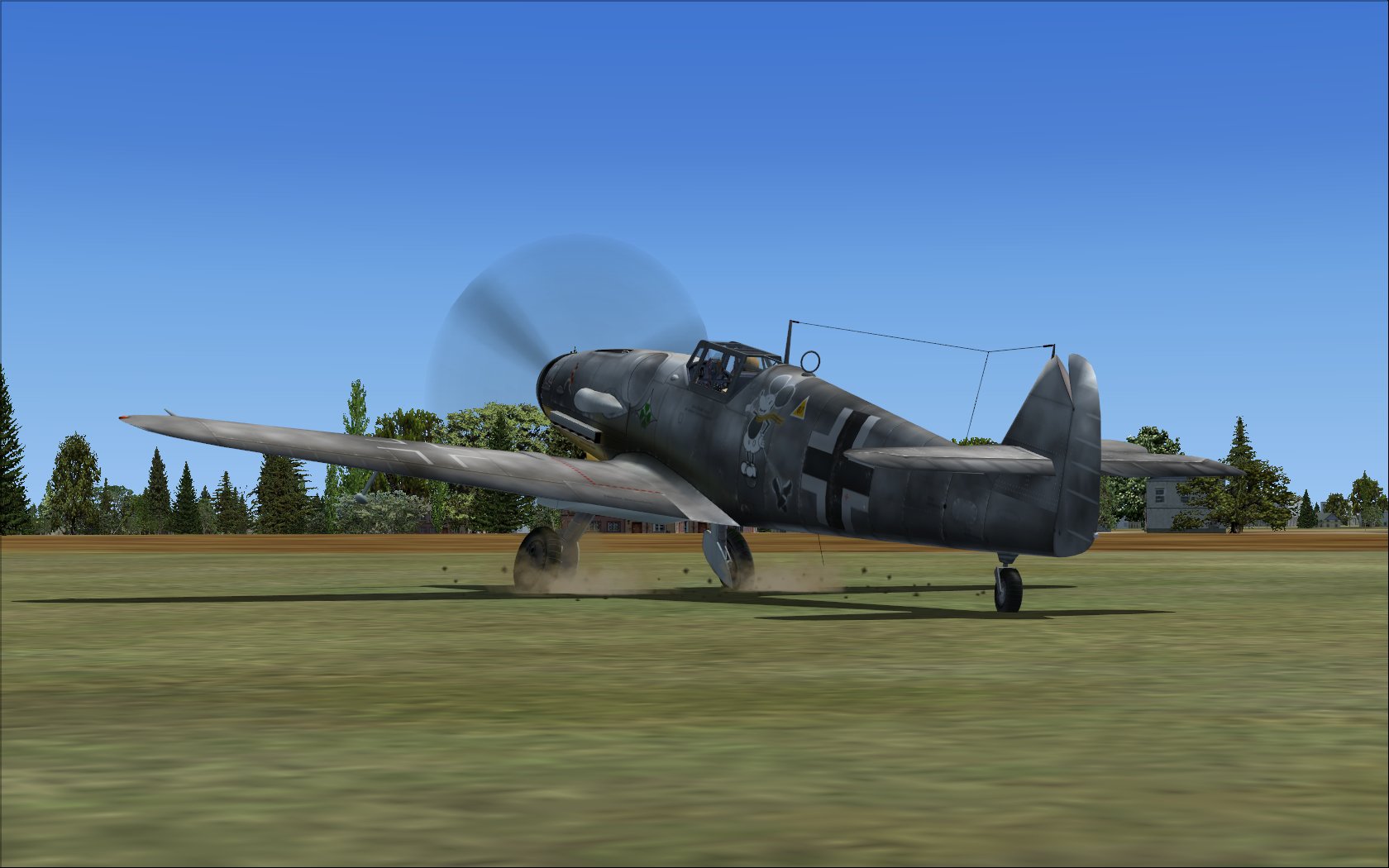
Speaking of obstructions, all tail wheel warbirds suffered with poor visibility forward with the tail wheel on the ground. The Bf-109 is about average in that respect, but two factors combine to make the effect more hazardous for ground operations. First, the canopy swings up and sideways vice sliding aft. This means you cannot taxi or takeoff with the canopy open. Combined with the very narrow cockpit, it's impossible to peak over the left and right side of the nose. You have no choice but to use the brakes and rudder to fishtail left and right while taxiing to avoid running into hazards. The second influence is the narrow width of the main landing gear. Combined with the toeing of the wheels, all these factors made the aircraft particularly challenging on the ground.
The ground steering with this aircraft is easier than I expected it would be. The rudder has good effect even at slow taxi speeds. The Bf-109 was a very lightweight aircraft, so this isn't entirely surprising. But I was surprised that I could turn the aircraft without needing to use differential braking. When you use them, the turn radius is improved significantly. Is this overly easy? It's hard to say having never flown this aircraft. I do know that many aircraft required differential braking to taxi and pilots made a point of mentioning this in their interview. I cannot recall reading or listening to a Bf-109 pilot complaining about the ineffectiveness of the rudder during taxi operations.
One thing is universal, it's in the air that
the Bf-109 blossoms into a lovely aircraft to fly. Pilots always reported
that it was faithful in the air, not having unexpected vices. Eric
Hartmann personally reported that the aircraft stalled benignly and with
sufficient warning buffet. He said unlike other fighters like the Fw-190,
the aircraft did not snap into a vicious spin during a stall. The CWDT
team captured this realistically enough. The plane stall straight ahead at
166 km/h and the stall is placid. The plane will tip over if you stall
with asymmetrical roll, but even then the spin is slow and easy to get out of.
Hartmann also reported that the Bf-109 will accelerate very quickly, especially
in a dive. Indeed, in this CWDT model, if you dive at full power you will
go from 300 km/h to above 600 km/h in mere seconds! Considering the
aircraft has a well documented frozen elevator problem above 700 km/h, you have
to pay close attention to your altitude and leave yourself sufficient margin to
recover from a dive. Even at sea level, the Vne (never exceed speed) is
750 km/h. Above that and structural damage is a real possibility.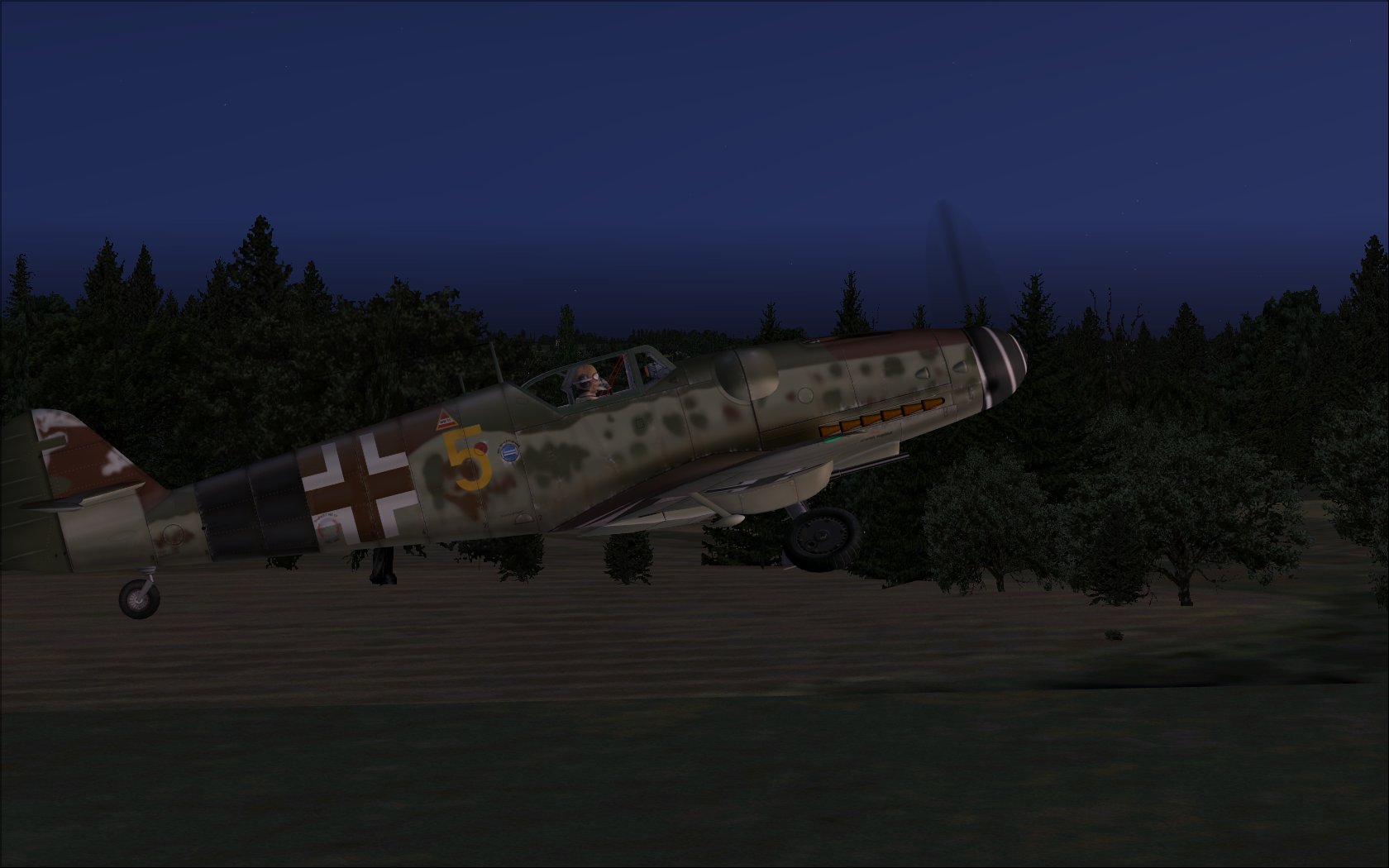
Speaking of critical speeds, the CWDT folks secured a rare copy of the official Messerschmitt pilot's manual. It lists only six critical indicated speeds! The flaps down speed limit is 250 km/h. The landing gear down speed is 350 km/h. There are four max speed limits (listed as "dive speeds" in the manual) indexed for altitude ranges. The team learned that these four different speeds all corresponded to Mach 0.75. Of course today, the Vne would be listed as a Mach ratio, but back in the late 1930's to mid 1940's they were listed as four separate indicated airspeeds because Mach ratios were in their infancy as known airframe critical speeds. From sea level to 4,000 meters, the Vne is 750 km/h. From 4,000 to 5,000 meters, it is 700 km/h. From 5k to 7k meters, it is 600 km/h. And lastly, from 7k to 9k meters, the Vne is 500 km/h. The thing about these speeds is that sometimes your airframe can survive speeds above those limits. The stress effects are often over time. You can get away with it a few times, but the wear on the aluminum and fabric is insidious, and could kill you on another day, even at a speed slightly below the limit.
The aircraft features other very realistic functions. For me, one I found particularly satisfying was the automatic deployment of the leading edge slats on the wings. Willy Messerschmitt designed the aircraft with thin wings with a relatively narrow chord (wing width from tip to stern). This allowed the aircraft to achieve then-record speeds in cruise flight. However, nothing in aviation is free. The price paid for this design choice was very high approach and landing speeds. But, the chief designer adopted two innovative solutions. He engineered revolutionary leading edge slats which above a specified angle of attack, the lower resistance of airflow across the wing's leading edge would allow these slats to fall down forward. This created a mini-wing on the leading edge of the main wing. This changed the flow of air over the wing, delaying the onset of stall at higher angle of attack. In order for an aircraft to support its weight with lift, as the speed decreases the angle of attack must increase to achieve the required lift at the lower speed. But without a change in the wing shape, above a certain angle of attack, the aircraft will stall. The deployment of the slats changed the wing shape, achieving additional lift at the lower speed.
In addition to this, Messerschmitt adopted a
rather complex flap deployment scheme, including drooping the ailerons and also
additional lower wing flaps integrated into the oil radiators. All these
innovations allowed the Bf-109 to have a rather friendly approach speed of
around 190 km/h. Interestingly, the official pilot's manual failed to
include this speed. However, a good rule of thumb for a pilot is to make
his approach speed around 1.2 time Vs (stall speed configured for landing).
Since you can experiment and confirm this CWDT model stalls around 166 km/h, I
figured the approach speed should be around 200 km/h. An American test
pilot flying a captured Bf-109 in 1944, documented that a "stable" approach
speed for the Bf-109 is "around" 190 km/h. So, once again, the CWDT nailed
the performance numbers plumb!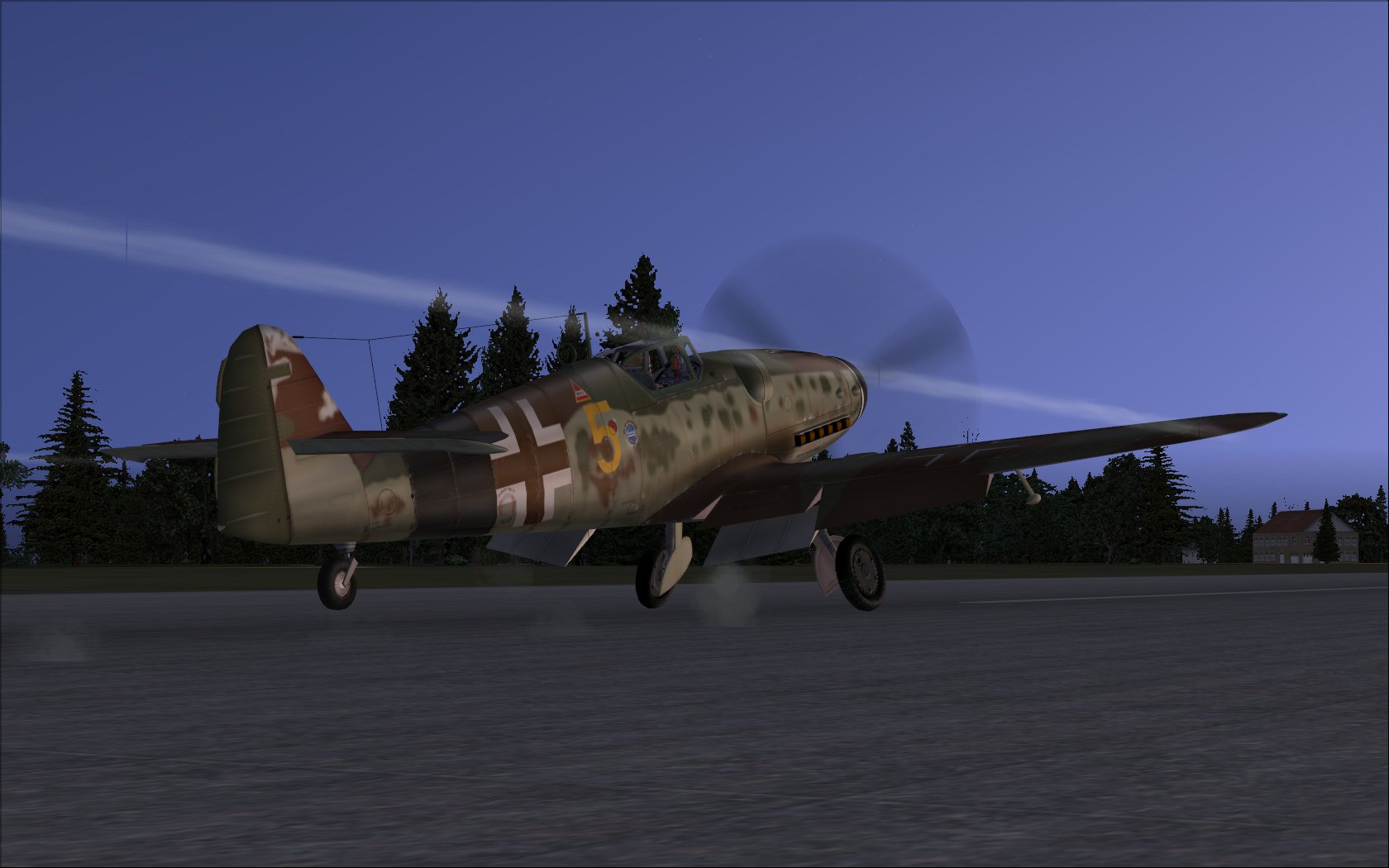
I have read some initial virtual pilots complain that they cannot perform a three-point landing with this aircraft. That report simply does not seem accurate. My own experience says you can absolutely land this aircraft on three wheels. All you do is the standard landing scheme. You cross the leading edge of the runway by retarding power to idle with the nose down, when you get half a wing length off the runway, you rotate to level flight and as the speed bleeds to stall, you keep pulling back on the stick and provided you don't touchdown well above stall speed, the plane will touchdown on all three wheels and stay there. Yes, you have to be ready to apply rudder to keep the nose pointed down the runway, and your vision is nearly blind ahead, but that's the real world with the Bf-109.
But again, the plane performs best in the air. Aerobatics are fun but you have to perform them properly. A barrel roll and aileron roll requires good and timely input of the rudder to make it snappy. If you try to do it only with the aileron, the roll gets stagnant when upside down. Loops require over 600 km/h entry speed and even then you must aggressively pull the stick back to get over the top before running out of airspeed. What I've read of aerobatics again says this is accurate, and with no personal experience with the Bf-109 I can only surmise this is all realistic to the actual aircraft.
During my test flights in FS-X, I flew out of Abbeyville Airport in France. I just thought it made so much sense considering the fame of the "Abbeyville Boys" led by Adolph Galland. I was lucky to find a Piper Cherokee 180 that made a nice formation flying buddy and pigeon for the gun run! Yeah, I know it violates good FAA flight regulations, but hey what's virtual aviation for anyway! LOL!!
Getting on the tail of the Cherokee made me
really lament the inability to do some old-fashioned shooting in FS-X.
Having lined up in his blind spot at six-o'clock low, the actual 30mm cannon
would have opened him up like a can! But it was still a satisfying
process, and even more fun trying to fly formation on the much slower cruising
aircraft. As you can see in the screenshots, slowing down the Bf-109 to
match the Cherokee produced a very high angle of attack. Yes, the slats
did deploy and the aircraft still flew reliably well, but also noticeably
sluggish as one would expect. Frankly, the thing I likes most about this
aircraft was in every aspect I encountered nothing in flight which made me
think, "this doesn't feel right." Nope, everything in the air felt right.
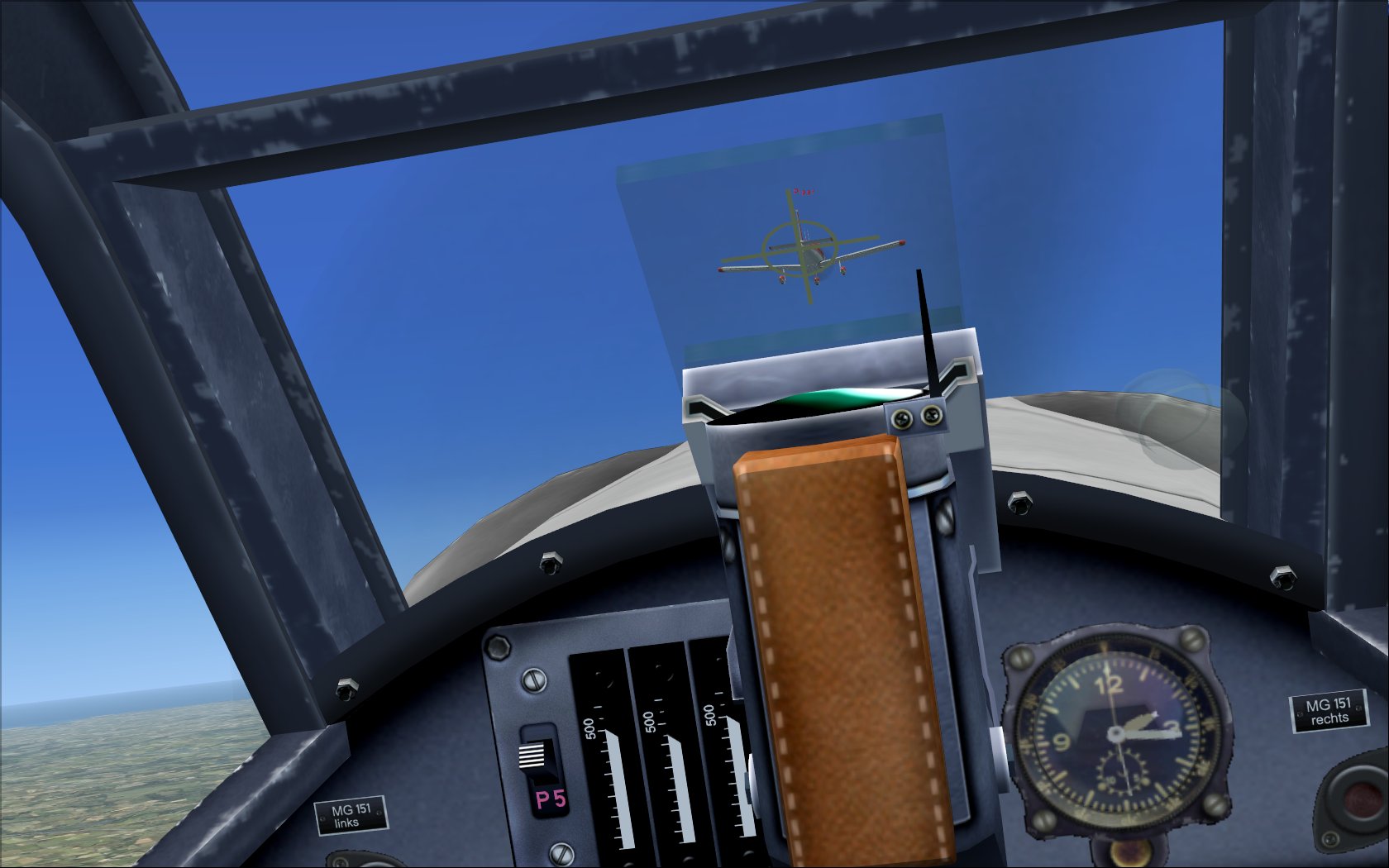 There
is a minor visual issue I wish all designers (and paying customers) would
appreciate. All the "effects" of propellers rotating "backwards," or
"suspending" while in motion are truly nothing other than visual illusions
created by motion picture cameras. When you are really flying an aircraft,
you can barely see the prop at all, and most often only see it when the sun is
in your eyes or off your tail. I spoke with the designers about this, but
they said despite knowing this, they have received many complaints in the past
from customers who complained that the "prop didn't look normal!" This is
kind of a personal crusade of mine, but I keep jousting the windmill anyway.
There
is a minor visual issue I wish all designers (and paying customers) would
appreciate. All the "effects" of propellers rotating "backwards," or
"suspending" while in motion are truly nothing other than visual illusions
created by motion picture cameras. When you are really flying an aircraft,
you can barely see the prop at all, and most often only see it when the sun is
in your eyes or off your tail. I spoke with the designers about this, but
they said despite knowing this, they have received many complaints in the past
from customers who complained that the "prop didn't look normal!" This is
kind of a personal crusade of mine, but I keep jousting the windmill anyway.
It was only during takeoff roll that I encountered something I felt might have been toned down a bit much. I didn't have to use very much right rudder to counter the extra p-effect with the tail on the ground. I wonder if the CWDT team didn't make a conscious decision to tone down this known reality in tail wheel flying to avoid predictable complaints from less experienced virtual pilots? Personally, I would prefer a bit more torque and twist from p-effect, but other than that, I found the takeoff realistic. With a clean aircraft (no ordinance) and full fuel tanks, the tail came up off the ground above 180 km/h, which is about right considering this is close to the speed you should rotate to climb off the runway surface. If you load up the bomb and fuel, then with the extra weight aft of the main gear, it takes more speed and forward stick pressure to get the tail off the ground. But, again, that's totally realistic.
Once in the air, I found best climbs were between 225 and 210 km/h. Again, the official Messerschmidt pilot's manual have no critical airspeeds published for best climb angle and best climb rate. Nor do they publish a rotate speed. I guess it was left to the pilots to figure it out for themselves! So, that's my vote! LOL!
There are so many well modeled aspects. The pilot figure is very nicely done. When you land, the pilot's face appears smudged with soot and slightly sunburned. Except he's also got the classic "raccoon" face with the area covered by the goggles and mask still a pure white! The mask comes on when the canopy closes. I asked the design team to consider linking that effect to altitude vice the canopy since most Luftwaffe pilots did not put on the oxygen mask until reaching a high enough altitude to require it.
Many Luftwaffe pilots preferred to fly without
goggles also, but I still like the pilot modeling very much. As you can
see from the screenshots, the modeler even got a texture effect going on the
helmet! Another thing shown by the two pilot images is the complex
modeling of the windscreen struts which was mentioned earlier. The curves
are precisely matched to the actual aircraft and this again is the first time
I've seen this done so faithfully. If you look carefully enough, you'll
even see the two small diagonal hand holds where the pilot held on when sitting
down in the seat, or when initially lifting himself off the seat! There's
a placard on the top of the cannon cover (inside the virtual cockpit between the
rudder pedals) that was placed there by the designers because they saw it in a
photo in the official Messerschmitt pilot's manual. Only problem is the
photo doesn't show the actual German writing on the placard. So, the
designers actually "wrote" on the placard that they are still researching what's
support to be written on the placard! It's a humorous discovery, but it
also points out the degree of research and sweat put into this effort.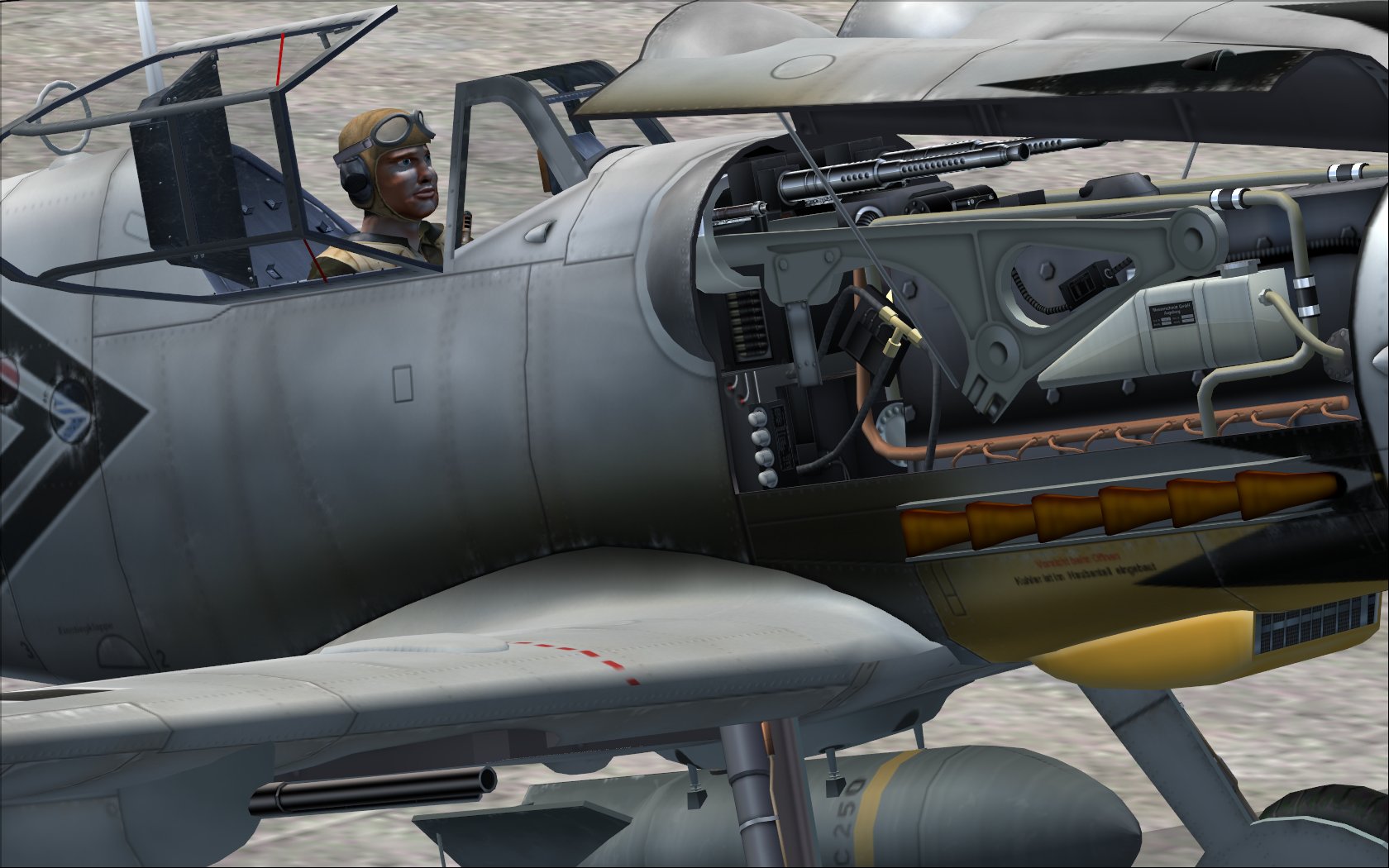
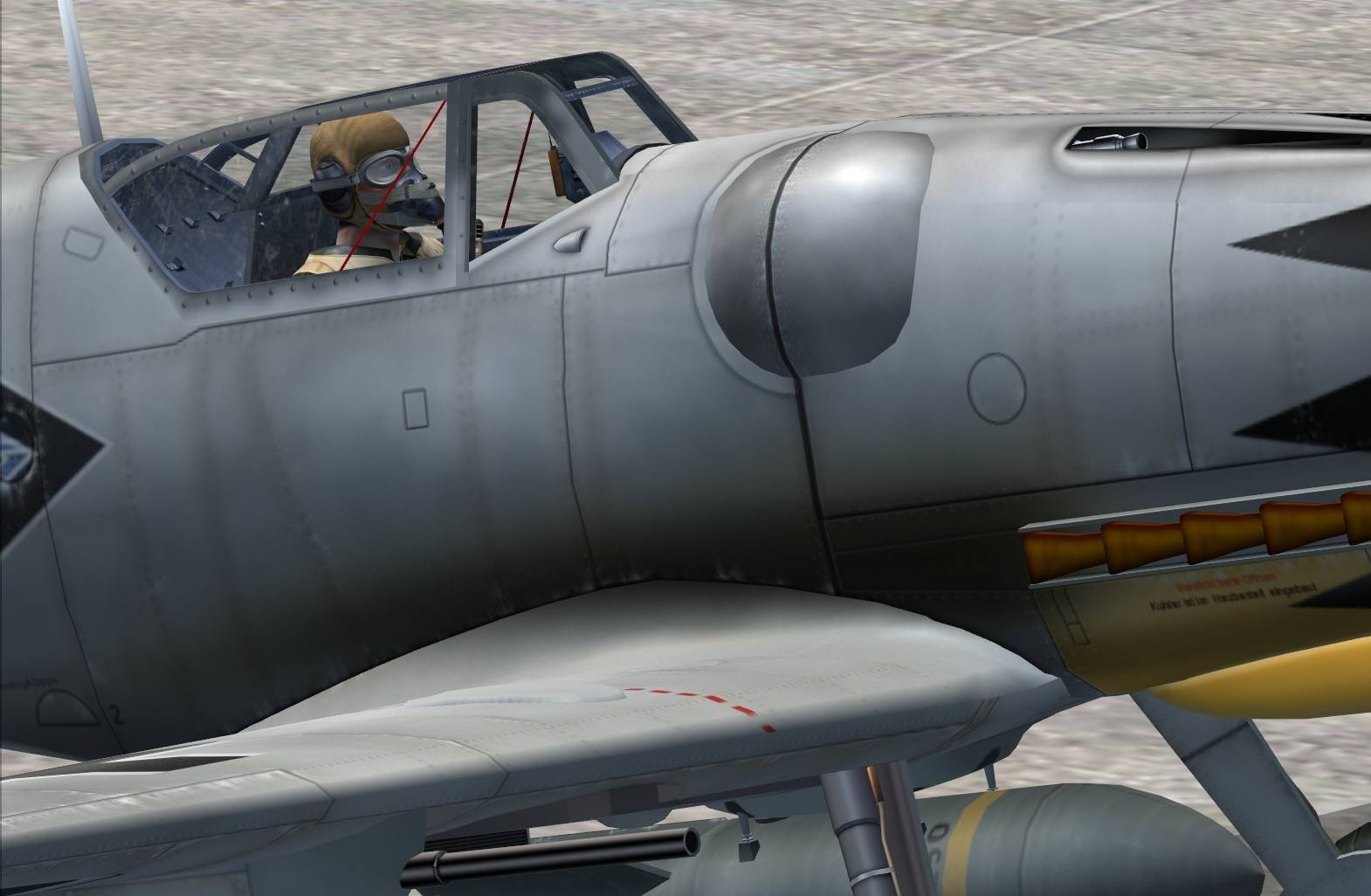
Overall, I found this CWDT Bf-109G a very satisfying experience. The team is working on a future release for a "native" FS-X version, which promises to fully support Direct-X 10 software. However, I found this release works most well in FS-X already. My advice for virtual pilots is to read the manual and pay particular attention to the information about weight and balance. If you load up this aircraft with all the bombs and fuel, it will be extremely sluggish in the air and the ground. Realize the ground ops with the nose and restrictive canopy adds to the challenge, but also the rewards of overcoming it.
There is always a fine balance between realism
and ease of flight. Make it truly fly like the real thing and suddenly
virtual pilots who have real jobs other than flying find it a very daunting
effort. They understandably complain and those in the business of selling
these aircraft always have to weigh the merits of realism for the demanding
"hard core" customers versus docility for those who treat this merely like a
game to play a few hours a week. While personally I would want more
clickable switches, more p-effect on takeoff, and a bit more snap in the spin, I
can completely understand why CWDT designed it as they did. Also,
especially with the spin, unless Gunter Rall was offering the feedback, it's
nothing more than a gut feel on my part about the spin effect.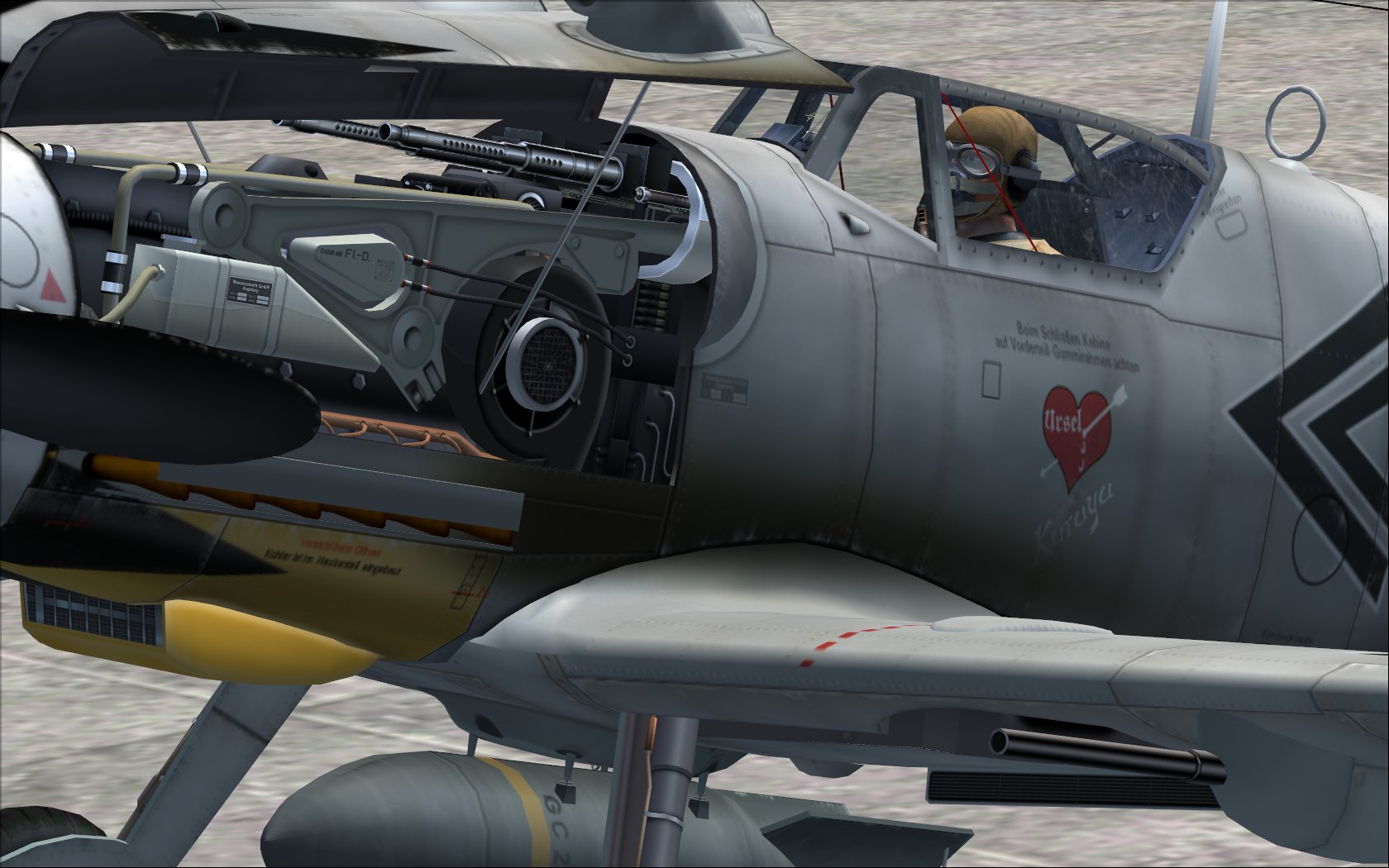
Another wonderful piece of eye candy is the engine. Again, with amazing fidelity, the CWDT designers rendered the exact modeling of how the maintenance crew would open the cowling to service the engine. Heck, they even included the small stick that swings out to hold the cowling in the up position! Having seen photos of the actual Daimler-Benz engine, there isn't a significant detail omitted from the team's efforts. I really enjoy seeing such efforts because they just add to the overall enjoyment of the ownership experience. When I ponder the state of the art back when CFS was the rage, it is amazing how far the art has come. The complexity of the designs, the fidelity of the flight models, and even the artistry of pilot figures are so far ahead of where we were. Seeing such depth of engine modeling was unheard of in times past.
So far, this review has focused upon visuals and flight dynamics. However, it is often the quality of the sounds that makes the flying experience come alive. The sounds on this package are to die for! Sharp and clear sound effects for flaps and gear. The engine is a joy to experience and well worth the price of a quality set of bass and treble speakers for your computer! My own are put to perfect use with this virtual aircraft. Again, I only wish you could shoot guns and drop bombs in FS-X. I am certain the roar of the 30mm cannon is awesome in CFS-2.
It is such a shame that Microsoft has decided to abandon the Flight Simulator series, at least for the PC. Combined with their previous move to abandon the Combat Flight Simulator series, I cannot understand their moves. With such exquisite designs released for the PC games, to shut out the avenues of such designers is almost criminal. If there are any future Flight Simulator titles released for X-Box, one must conclude it will not support freeware and payware add-on development. We should really enjoy aircraft releases for FS-X such as this one. We don't really know what the future of this gig looks like!
Regardless of all that, I highly recommend
this aircraft. I think it's fairly priced in today's era at the $25 mark
(depending upon the Euro exchange rate). For all this you get several
liveries, two different cockpit canopies, several different weapons load-outs, a
very nice virtual manual, and ongoing work to release updates to tweak stuff
based upon customer feedback. The total commitment for excellence is
there. Further, based upon Bf-109 pilot writings and interviews, it
appears CWDT did a really nice job capturing the look and feel of this aircraft.
Strong points are the virtual cockpit design and the realistic impact of
load-outs on flight dynamics. Based upon what we know, the overall flight
model appears solid. In my view, it's the full package and one that will
offer a long period of enjoyment for all flight simulator enthusiasts.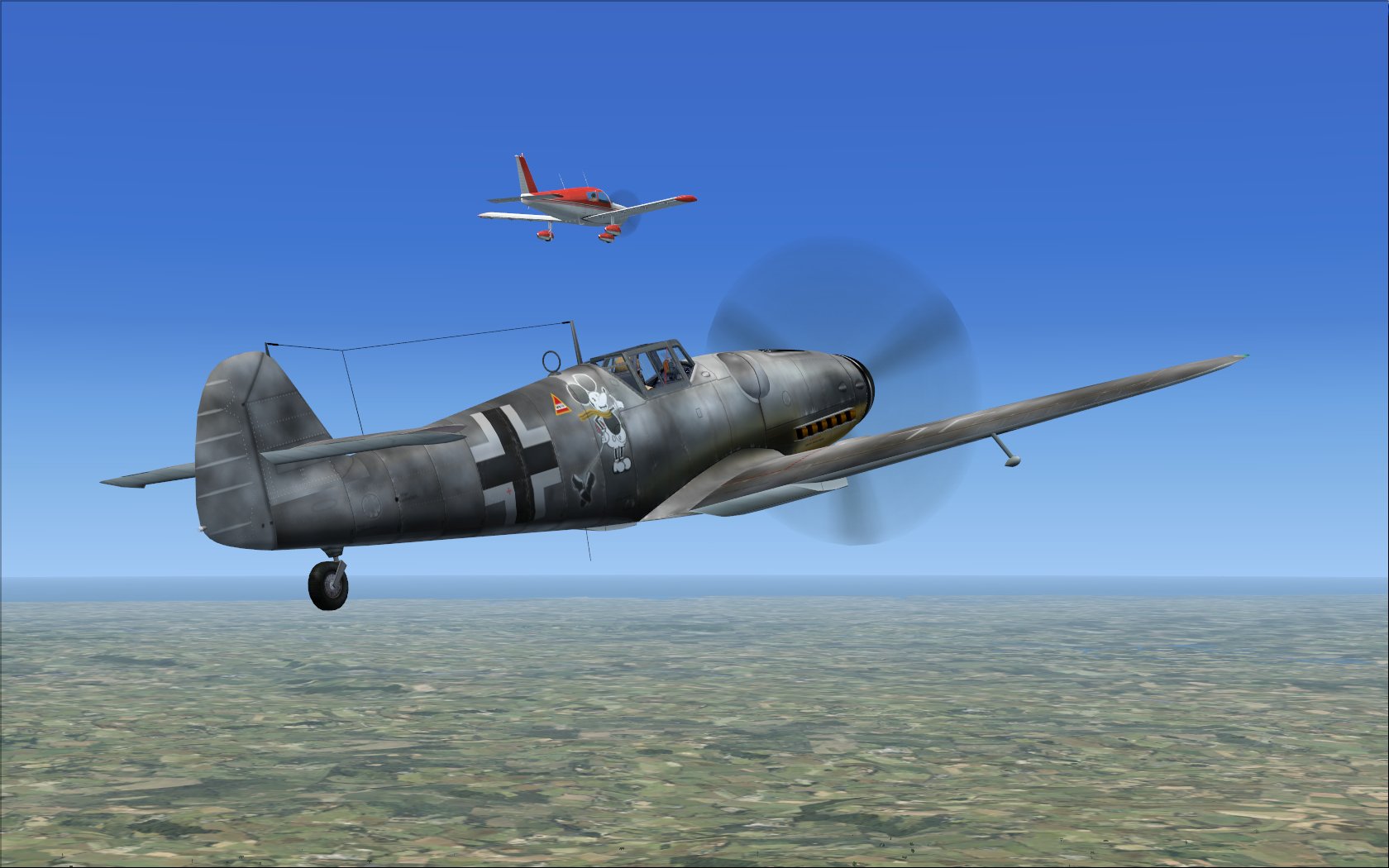
Cheers,
Ken Stallings
Ken Stallings is a licensed FAA Commercial AMEL/ASEL pilot and USAF Instructor Pilot. He also owns a Cessna Skyhawk (N733CZ).